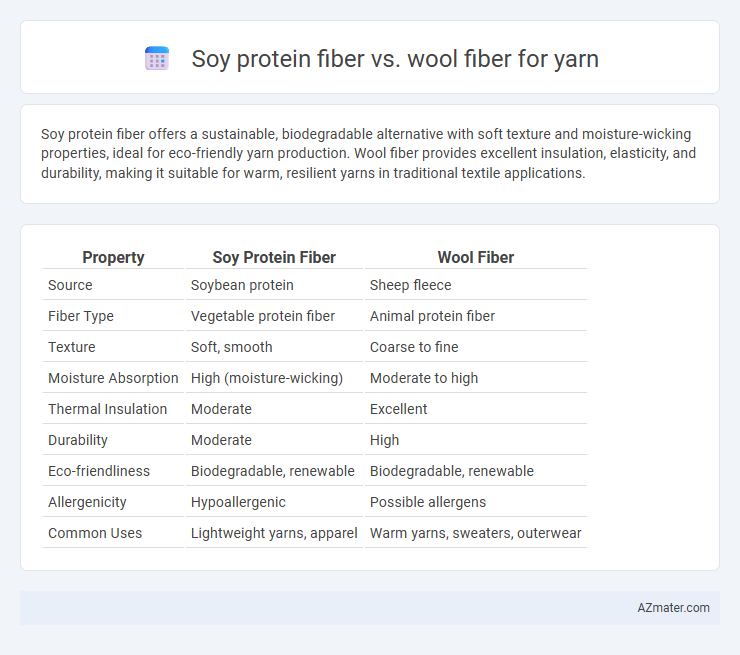Soy protein fiber offers a sustainable, biodegradable alternative with soft texture and moisture-wicking properties, ideal for eco-friendly yarn production. Wool fiber provides excellent insulation, elasticity, and durability, making it suitable for warm, resilient yarns in traditional textile applications.
Table of Comparison
| Property | Soy Protein Fiber | Wool Fiber |
|---|---|---|
| Source | Soybean protein | Sheep fleece |
| Fiber Type | Vegetable protein fiber | Animal protein fiber |
| Texture | Soft, smooth | Coarse to fine |
| Moisture Absorption | High (moisture-wicking) | Moderate to high |
| Thermal Insulation | Moderate | Excellent |
| Durability | Moderate | High |
| Eco-friendliness | Biodegradable, renewable | Biodegradable, renewable |
| Allergenicity | Hypoallergenic | Possible allergens |
| Common Uses | Lightweight yarns, apparel | Warm yarns, sweaters, outerwear |
Introduction to Soy Protein Fiber and Wool Fiber
Soy protein fiber, derived from soybean residue, offers a sustainable, biodegradable alternative to traditional fibers with a soft texture and moisture-wicking properties ideal for yarn production. Wool fiber, sourced from sheep fleece, provides natural insulation, elasticity, and durability, making it a preferred choice for warm, breathable yarns. Both fibers cater to distinct textile needs, with soy protein fiber emphasizing eco-friendliness and wool prioritizing performance in thermal regulation.
Origins and Production Processes
Soy protein fiber originates from defatted soybean flakes, a byproduct of soybean oil extraction, transformed through a wet spinning process that converts soy protein into a soft, biodegradable fiber ideal for yarn. Wool fiber is derived from the fleece of sheep, harvested through shearing and subsequently scoured, carded, and spun to produce natural, insulating yarn with excellent elasticity. The production of soy protein fiber emphasizes sustainability by utilizing agricultural waste, whereas wool fiber production relies on animal husbandry and traditional fiber processing techniques.
Chemical Composition Comparison
Soy protein fiber consists primarily of amino acids like alanine, glycine, and serine, with a high percentage of proteins similar to silk, providing good moisture absorption and biodegradability. Wool fiber is rich in keratin, composed mainly of cysteine, glycine, and tyrosine, featuring disulfide bonds that contribute to its elasticity, thermal insulation, and water repellency. The key chemical difference lies in soy fiber's predominant protein structure facilitating softness and biodegradability, whereas wool's keratin structure offers durability and natural crimp.
Physical Properties: Strength and Softness
Soy protein fiber exhibits notable softness and a smooth texture, making it highly comfortable for yarn applications, though its tensile strength is moderate compared to traditional fibers. Wool fiber offers superior strength and elasticity, providing durability and resilience in yarn, while maintaining a natural softness that enhances wearability. Combining the two fibers can result in yarns that balance the softness of soy protein with the robust strength and elasticity of wool.
Moisture Absorption and Breathability
Soy protein fiber exhibits superior moisture absorption compared to wool fiber, effectively wicking sweat away from the skin to maintain dryness. Wool fiber provides excellent breathability through its natural crimp, allowing air circulation that regulates temperature and enhances comfort. Both fibers offer moisture management benefits, but soy protein fiber excels in rapid moisture uptake while wool ensures continuous airflow and ventilation.
Environmental Impact and Sustainability
Soy protein fiber yarn is a biodegradable and renewable material derived from soybeans, offering a lower carbon footprint compared to traditional wool fiber yarn. Wool fiber, sourced from sheep, requires extensive land use and water consumption, contributing to greenhouse gas emissions such as methane. Soy protein fiber production typically uses less water and energy, making it a more sustainable option for eco-conscious textile manufacturing.
Comfort and Skin Sensitivity
Soy protein fiber offers superior softness and moisture-wicking properties, making it highly comfortable and gentle on sensitive skin compared to wool fiber. Wool fiber, while durable and insulating, can sometimes cause irritation or itchiness for individuals with sensitive skin due to its coarse texture and lanolin content. Soy protein fiber's hypoallergenic nature and smooth texture provide a breathable, soothing alternative for sensitive skin in yarn applications.
Dye Affinity and Color Fastness
Soy protein fiber exhibits excellent dye affinity due to its protein-based structure, allowing vibrant and uniform coloration when dyed. It provides good color fastness, maintaining hues well through washing and light exposure, although often slightly less durable than wool. Wool fiber inherently binds strongly with dyes, especially acid dyes, resulting in superior colorfastness and resistance to fading, making it ideal for yarns requiring long-lasting vibrancy.
Yarn Applications and Uses
Soy protein fiber offers a soft, eco-friendly alternative for yarn used in apparel such as T-shirts, scarves, and baby clothes, prized for its moisture-wicking and breathability properties. Wool fiber excels in yarn for warm clothing, blankets, and upholstery due to its natural insulation, elasticity, and durability. Both fibers support distinct applications where soy emphasizes sustainability and comfort, while wool provides superior thermal regulation and resilience.
Price and Market Availability
Soy protein fiber yarn tends to be more affordable than wool yarn due to lower raw material and processing costs, making it an economical choice for sustainable textile production. Wool yarn, priced higher because of its natural sourcing, durability, and insulating properties, dominates premium and winter apparel markets where quality commands a premium. Soy protein fiber yarn is increasingly available in mainstream markets but remains less widespread than wool, which benefits from longstanding established supply chains and global demand.

Infographic: Soy protein fiber vs Wool fiber for Yarn
 azmater.com
azmater.com